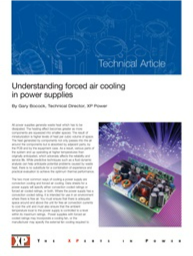Understanding forced air cooling in power supplies
All power supplies generate waste heat which has to be dissipated. The heating effect becomes greater as more components are squeezed into smaller spaces. The result of miniaturization is higher levels of heat per cubic volume of space.
The heat generated by components not only passes into the air around the components but is absorbed by adjacent parts, by the PCB and by the equipment case. As a result, various parts of the system end up operating at higher temperatures than originally anticipated, which adversely affects the reliability and service life.
Download this whitepaper to learn more.
Read More
By submitting this form you agree to XP Power contacting you with marketing-related emails or by telephone. You may unsubscribe at any time. XP Power web sites and communications are subject to their Privacy Notice.
By requesting this resource you agree to our terms of use. All data is protected by our Privacy Notice. If you have any further questions please email dataprotection@techpublishhub.com
Related Categories: Capacitors, Components, cooling, Power


More resources from XP Power

No load power consumption and efficiency legislation for external power supplies
Two important reasons for wanting to control the power taken by an external power supply are continuity of the energy supply and reduction of envir...

Pushing the limits of AC/DC power system design to meet the demands of medical applications
While it's clear that reductions in size and improvements in efficiency are constant pressures in the design of AC/DC power supplies, the medical d...

XP Tips and Tricks
XP Power offers advice on power supply design, which could help with your next design. Most electronics engineers can design an AC/DC power supply ...
